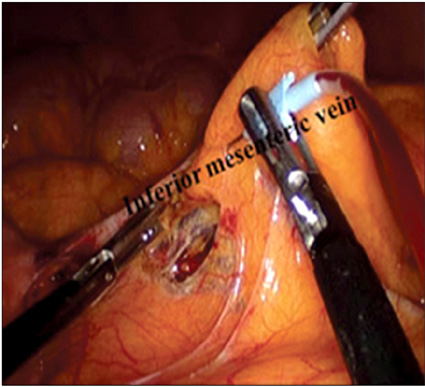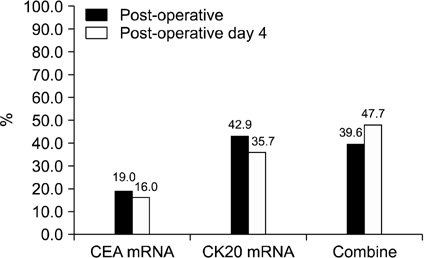J Korean Surg Soc.
2012 Jun;82(6):356-364.
Influence of surgical manipulation and surgical modality on the molecular detection of circulating tumor cells from colorectal cancer
- Affiliations
-
- 1Colorectal Cancer Center, Kyungpook National University Medical Center, Kyungpook National University School of Medicine, Daegu, Korea. kyuschoi@mail.knu.ac.kr
Abstract
- PURPOSE
The aim of this study was to evaluate the relationship between the detection of circulating tumor cell molecular markers from localized colorectal cancer and the time-course of a surgical manipulation or surgical modality.
METHODS
From January 2010 to June 2010, samples from the peripheral blood and the inferior mesenteric vein were collected from 42 patients with cancer of the sigmoid colon or rectum. Pre-operative, intra-operative (both pre-mobilization and post-mobilization), and post-operative samples were collected. We examined carcinoembryonic antigen (CEA) mRNA and cytokeratin-20 (CK20) mRNA by real-time reverse-transcriptase polymerase chain reaction. Changes in mRNA detection rates were analyzed according to the time of blood sample collection, the surgical modality, and patient clinicopathological features.
RESULTS
mRNA expression rates before surgical resection did not differ between blood samples from the peripheral and inferior mesenteric veins. The detection rate for CEA and CK20 mRNA showed a tendency to increase after operative mobilization of the cancer-bearing bowel segment. Furthermore, the cumulative detection rates for CEA and CK20 mRNA increased significantly over the course of surgery (pre-mobilization vs. post-mobilization). The cumulative detection rate decreased significantly after surgical resection compared with the pre-operative rates. However, no significant difference was observed in the detection rates between different surgical modalities (laparoscopy vs. open surgery).
CONCLUSION
The results of this study suggest that surgical manipulation has a negative influence on the dissemination of circulating tumor cells during operations on localized colorectal cancer. However, the type of surgical technique did not affect circulating tumor cells.
Keyword
MeSH Terms
Figure
Reference
-
1. Shibata D, Paty PB, Guillem JG, Wong WD, Cohen AM. Surgical management of isolated retroperitoneal recurrences of colorectal carcinoma. Dis Colon Rectum. 2002. 45:795–801.2. Manfredi S, Bouvier AM, Lepage C, Hatem C, Dancourt V, Faivre J. Incidence and patterns of recurrence after resection for cure of colonic cancer in a well defined population. Br J Surg. 2006. 93:1115–1122.3. Fehm T, Sagalowsky A, Clifford E, Beitsch P, Saboorian H, Euhus D, et al. Cytogenetic evidence that circulating epithelial cells in patients with carcinoma are malignant. Clin Cancer Res. 2002. 8:2073–2084.4. Engell HC. Cancer cells in the circulating blood; a clinical study on the occurrence of cancer cells in the peripheral blood and in venous blood draining the tumour area at operation. Acta Chir Scand Suppl. 1955. 201:1–70.5. Romsdahl MM, McGrath RG, Hoppe E, McGrew EA. Experimental model for the study of tumor cells in the blood. Acta Cytol. 1965. 9:141–145.6. Nishizaki T, Matsumata T, Kanematsu T, Yasunaga C, Sugimachi K. Surgical manipulation of VX2 carcinoma in the rabbit liver evokes enhancement of metastasis. J Surg Res. 1990. 49:92–97.7. Fisher ER, Turnbull RB Jr. The cytologic demonstration and significance of tumor cells in the mesenteric venous blood in patients with colorectal carcinoma. Surg Gynecol Obstet. 1955. 100:102–108.8. Turnbull RB Jr, Kyle K, Watson FR, Spratt J. Cancer of the colon: the influence of the no-touch isolation technic on survival rates. Ann Surg. 1967. 166:420–427.9. Atkin G, Chopada A, Mitchell I. Colorectal cancer metastasis: in the surgeon's hands? Int Semin Surg Oncol. 2005. 2:5.10. Khair G, Monson JR, Greenman J. Epithelial molecular markers in the peripheral blood of patients with colorectal cancer. Dis Colon Rectum. 2007. 50:1188–1203.11. Sergeant G, Penninckx F, Topal B. Quantitative RT-PCR detection of colorectal tumor cells in peripheral blood--a systematic review. J Surg Res. 2008. 150:144–152.12. Sakakura C, Takemura M, Hagiwara A, Shimomura K, Miyagawa K, Nakashima S, et al. Overexpression of dopa decarboxylase in peritoneal dissemination of gastric cancer and its potential as a novel marker for the detection of peritoneal micrometastases with real-time RT-PCR. Br J Cancer. 2004. 90:665–671.13. Zehentner BK. Detection of disseminated tumor cells: strategies and diagnostic implications. Expert Rev Mol Diagn. 2002. 2:41–48.14. Thorsteinsson M, Jess P. The clinical significance of circulating tumor cells in non-metastatic colorectal cancer: a review. Eur J Surg Oncol. 2011. 37:459–465.15. Peach G, Kim C, Zacharakis E, Purkayastha S, Ziprin P. Prognostic significance of circulating tumour cells following surgical resection of colorectal cancers: a systematic review. Br J Cancer. 2010. 102:1327–1334.16. Koch M, Kienle P, Hinz U, Antolovic D, Schmidt J, Herfarth C, et al. Detection of hematogenous tumor cell dissemination predicts tumor relapse in patients undergoing surgical resection of colorectal liver metastases. Ann Surg. 2005. 241:199–205.17. Ito S, Nakanishi H, Hirai T, Kato T, Kodera Y, Feng Z, et al. Quantitative detection of CEA expressing free tumor cells in the peripheral blood of colorectal cancer patients during surgery with real-time RT-PCR on a LightCycler. Cancer Lett. 2002. 183:195–203.18. Han SA, Lee WY, Park CM, Yun SH, Chun HK. Comparison of immunologic outcomes of laparoscopic vs open approaches in clinical stage III colorectal cancer. Int J Colorectal Dis. 2010. 25:631–638.19. Tomita H, Marcello PW, Milsom JW, Gramlich TL, Fazio VW. CO2 pneumoperitoneum does not enhance tumor growth and metastasis: study of a rat cecal wall inoculation model. Dis Colon Rectum. 2001. 44:1297–1301.20. Ishida H, Hashimoto D, Nakada H, Takeuchi I, Hoshino T, Murata N, et al. Increased insufflation pressure enhances the development of liver metastasis in a mouse laparoscopy model: possible mechanisms. Surg Endosc. 2002. 16:331–335.21. Chen WS, Chung MY, Liu JH, Liu JM, Lin JK. Impact of circulating free tumor cells in the peripheral blood of colorectal cancer patients during laparoscopic surgery. World J Surg. 2004. 28:552–557.22. Wind J, Tuynman JB, Tibbe AG, Swennenhuis JF, Richel DJ, van Berge Henegouwen MI, et al. Circulating tumour cells during laparoscopic and open surgery for primary colonic cancer in portal and peripheral blood. Eur J Surg Oncol. 2009. 35:942–950.23. Bessa X, Castells A, Lacy AM, Elizalde JI, Delgado S, Boix L, et al. Laparoscopic-assisted vs. open colectomy for colorectal cancer: influence on neoplastic cell mobilization. J Gastrointest Surg. 2001. 5:66–73.24. Jayne DG, Thorpe HC, Copeland J, Quirke P, Brown JM, Guillou PJ, et al. Five-year follow-up of the Medical Research Council CLASICC trial of laparoscopically assisted versus open surgery for colorectal cancer. Br J Surg. 2010. 97:1638–1645.25. Fleshman J, Sargent DJ, Green E, Anvari M, Stryker SJ, Beart RW Jr, et al. Laparoscopic colectomy for cancer is not inferior to open surgery based on 5-year data from the COST Study Group trial. Ann Surg. 2007. 246:655–662.26. Iinuma H, Okinaga K, Egami H, Mimori K, Hayashi N, Nishida K, et al. Usefulness and clinical significance of quantitative real-time RT-PCR to detect isolated tumor cells in the peripheral blood and tumor drainage blood of patients with colorectal cancer. Int J Oncol. 2006. 28:297–306.27. Weitz J, Koch M, Kienle P, Schrodel A, Willeke F, Benner A, et al. Detection of hematogenic tumor cell dissemination in patients undergoing resection of liver metastases of colorectal cancer. Ann Surg. 2000. 232:66–72.28. Lee SY, Min KS, Chung JK, Jung IM, Ahn YJ, Hwang KT, et al. Carcinoembryonic antigen level of draining venous blood as a predictor of recurrence in colorectal cancer patient. J Korean Surg Soc. 2011. 81:387–393.29. Sadahiro S, Suzuki T, Maeda Y, Yurimoto S, Yasuda S, Makuuchi H, et al. Detection of carcinoembryonic antigen messenger RNA-expressing cells in peripheral blood 7 days after curative surgery is a novel prognostic factor in colorectal cancer. Ann Surg Oncol. 2007. 14:1092–1098.
- Full Text Links
- Actions
-
Cited
- CITED
-
- Close
- Share
- Similar articles
-
- Circulating Tumor Cells and Extracellular Nucleic Acids in Breast Cancer
- Role of βâ‚-Integrin in Colorectal Cancer: Case-Control Study
- Role of beta1-Integrin in Colorectal Cancer: Case-Control Study
- Role of Liquid Biopsies in Colorectal Cancer
- Circulating Tumor Cells: Detection Methods and Potential Clinical Application in Breast Cancer






